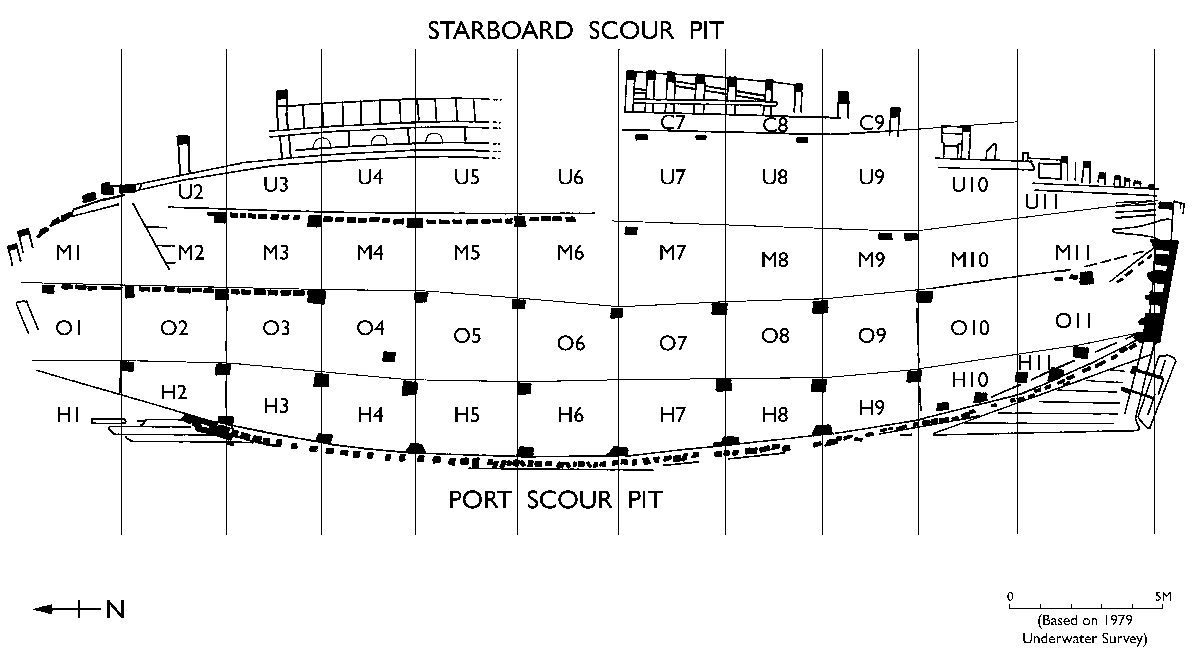From the outset the divers and archaeologists on the Mary Rose strove to achieve the highest standards of archaeology possible. They sought out the very latest techniques, and adapted them to the conditions. They approached leading institutions and companies for advice, expertise and equipment.
The Mary Rose wreck site was one of the first underwater sites in England to be worked using a team of volunteer divers led by a small number of professional archaeologists. It was also the first underwater project in England to have a full-time team on shore to record and analyse all the finds.
Mary Rose archaeology, only the best of the best and often the first!
Striving to understand the deposition of layers of sediment within the ship over time, it was decided to open up the entire site and try to excavate it layer by layer rather than to dig small, discrete trenches. With limited visibility and a complicated tidal system, this was challenging, but it did provide a clearer understanding of the structure of the ship and the site stratigraphy.

Noting the differences in layers of sediments – their texture and inclusions led to employing an environmental archaeologist who dived, yet another first!
The project has achieved a number of ‘firsts’ in the world of archaeology:
- First site in England to be found by sub-bottom profiling.
- First site in England to be positioned using underwater acoustics linked to GPS.
- One of the sites instrumental to the creation of the Protection of Wrecks Act, (1973) and the experience and knowledge gained during the excavation contributed to the HSE Diving at Work Regulations (1981).
Changing archaeology for the future
The project was extremely important in helping further scientific understanding of how marine sites degrade over time, and how to preserve objects and structure whilst working on the site.
During the excavation small blocks of different species of wood were attached to poles so they could float within the water column. Recovered at different intervals of time, this helped the team to understand how different woods erode, degrade or become infested with marine boring organisms. The team pioneered the use of terram, a protective material, to cover any exposed ship’s structure between diving seasons. This later developed into research projects reburying different materials around the site to monitor deterioration and the use of data loggers to log conditions both in the water and within the sediments.
This preservation ‘in situ’ is now the preferred option rather than recovering large numbers of objects and structure.
The wealth of objects found on the Mary Rose also helps to date similar objects found on other sites, either by sight or by detailed chemical, biochemical and molecular analysis.
In order to interpret the collection to present to the public it is important to understand the function of objects, and how they are used. Archaeologists from the Mary Rose have been instrumental in leading research projects including experimental archaeology. Recreating activities such cooking on a replica of the Mary Rose galley, or using Tudor techniques to reproduce elements of structure found on the ship, or manufacturing and testing copies of the weapons recovered.
Historians have also replicated a wide range of domestic and personal possessions. This has enabled them to understand the working methods of artisans in Tudor times.
Furthering expertise
Staff involved in the archaeological work at the Mary Rose are helping to build skills and knowledge around the world.
A number of staff now sit on national or international committees, others teach future generations of archaeologists, or work in the media. These individuals provide information and direct help to many other historic wreck sites across the UK and around the world.
Conservation, curatorial and archaeological services are also available through Mary Rose Archaeological Services Ltd, find out more here.